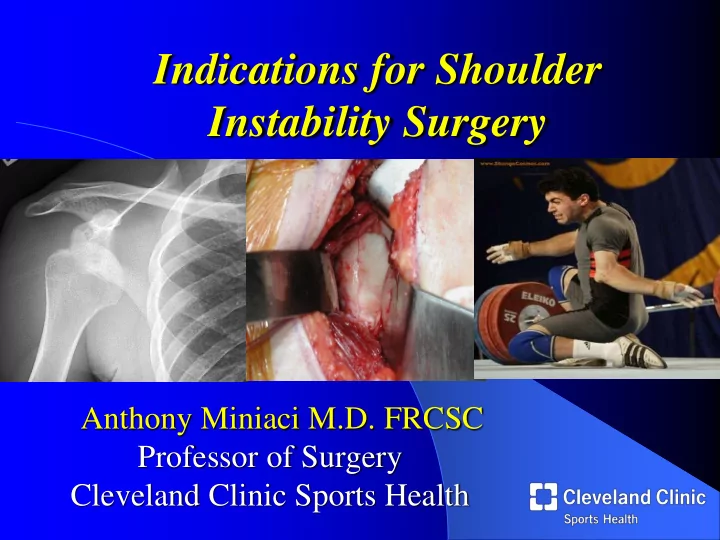

Indications for Shoulder Instability Surgery Anthony Miniaci M.D. FRCSC Professor of Surgery Cleveland Clinic Sports Health
Indications for Shoulder Instability Surgery Considerations Instability classification Natural history Patient demographics-age, activity level, occupation, associated morbidities Associated pathology Prior treatments
Instability Classification: Spectrum Unidirectional “Classic” MDI More surgery on “MDI” Multidirectional instability lacks definitions-”MDI” has grown?
Shoulder Instability Surgery…………………………..Rehabilitation
Multidirectional Instability Lack of definitions 1. Patient population 2. Symptom definition 3. Surgical pathology
Multidirectional Instability Patient Population Type of instability - voluntary, involuntary, Voluntary, positional, habitual Posterior,Traumatic Direction- anterior, posterior,multi Anterior, Injury pattern- none, Involuntary Atraumatic trauma, atraumatic (“born, torn, worn loose”) Multi, Involuntary, Laxity- degree, focal vs. Atraumatic general, symmetry
Multidirectional Instability ! Laxity vs. Instability 2. Symptom Definition - pain, Instability or Both Be sure looseness is - Instability- degree source of Sx (subluxation/dislocation) Watch out for neck, - Apprehension, AC joint, etc. microinstability Reproduce symptoms with subluxation
The MDI patient pathology- Imaging Studies Capsular laxity Rotator cuff tears Leakage of dye Labral Tears
Arthroscopic Capsular Shifts Best results in milder forms of instability (subluxation), multidirectional laxity, anteroinferior instability with MD laxity Good for patients with PAIN and laxity Associated pathology best treated arthroscopically
What about Posterior Instability? Dislocation Fixed, Chronic Recurrent Subluxation Traumatic Micro macro Muscular- Voluntary Scapula winging Asymmetric muscular contraction Positional- Involuntary
What about Posterior Instability? Dislocation Fixed, Chronic Recurrent Subluxation Traumatic Micro macro Muscular- Voluntary Scapula winging Asymmetric muscular contraction Positional- Involuntary
What about Posterior Instability? Dislocation Fixed, Chronic Recurrent Subluxation Traumatic Micro macro Muscular- Voluntary Scapula winging Asymmetric muscular contraction Positional- Involuntary
What about Posterior Dislocation ?
Posterior Dislocation- Arthroscopy Posterior Reverse Hill Sachs Lesion Glenoid
Posterior Instability/Subluxation Repetitive microtrauma → posterior labral/ligamentous/capsular attenuation & tearing RPS – Recurrent Posterior Subluxation Weightlifters, Linemen, tennis players, throwers, swimmer Present with vague and diffuse posterior shoulder pain Not typical to have recurrent dislocations Pathoanatomy posterior labrum, post capsule and posterior part of IGHL
Treatment Non operative Rehabilitation, biofeedback, proprioceptive training Cuff, deltoid, periscapular strengthening Surgical Several options exist – arthroscopic/open capsulolabral reconstruction Arthroscopic labral repair Anatomic, minimally invasive, effective
Anterior Instability Epidemiology Most common Bimodal distribution 2 nd & 6 th decades 96% result from traumatic event Overall incidence 1.7% ~3 times incidence in males Recurrent Shoulder Instability Age-related recurrence following traumatic anterior instability < 20 years old – 66-94% 20 to 40 years old – 40-74% > 40 years old – 10%- ROTATOR CUFF tears Rowe et al., ‘56; Hovelius et al. ‘82
Recurrent Instability Associated pathology Osteoarthritis Hovelius JSES ’ 09 Nonoperative tx with 1 more recurrence had more arthropathy Buscayret AJSM ‘04 number of dislocations linked to risk for postop OA Ogawa AJSM ‘10 5-20 yr f/u study of 167 open Bankarts evaluated with pre and postop CT Postop OA correlates with increased number of instability events
• 127 patients; diagnostic arthroscopy, x-rays (AP, Glenoid, West Point), MRI Arthroscopy
Anterior Shoulder Instability Surgical Pathology Labral tears Capsular redundancy Unrecognized Pathology Capsular Deficiencies/Avulsions Labral pathology/ALPSA Subscapularis tears- Open BONE LOSS Glenoid erosion or fractures(Bankart) Hill-Sachs defects
Treatment options Glenoid Bone Loss Humeral Bone Loss 1. Bristow /Latarjet 1. Remplissage 2. Bone Graft- auto/allo 2. Decreased ER 3. Arthroplasty
Glenoid Bone Loss <20% may treat arthroscopically/ soft tissue/open Larger defect requires open fixation if bone stock adequate Quantify with 3D CT Consider combined effect of a humeral defect- treat smaller lesions Provencher et. al. JBJS, 2010 Bois, Jones, Miniaci et. al. AJSM, 2012
Glenoid Bone Loss <20% may treat arthroscopically/ soft tissue/open Larger defect requires open fixation if bone stock adequate Quantify with 3D CT Consider combined effect of a humeral defect- treat smaller lesions Provencher et. al. JBJS, 2010 Bois, Jones, Miniaci et. al. AJSM, 2012
What about the Hill Sachs ?
Hill Sachs >25-30% Humeral Head must be addressed Remplissage French for “to fill” Infraspinatus tucked into defect Probably not enough when defect is >25% Provencher et al., JAAOS, 2012
Hill Sachs >25-30% Humeral Head must be addressed Remplissage French for “to fill” Infraspinatus tucked into defect Probably not enough when defect is >25% Provencher et al., JAAOS, 2012
2013 Anatomic Reconstruction Options Matched Allograft Autogenous Iliac crest Autograft Focal Resurfacing Option Both studies with reported 0% redislocation Preservation of motion!!
Combined Humeral Head and Glenoid Reconstruction
Shoulder Instability Surgery Summary Know your patient Demographics, activity etc Know the pathology Type of instability Associated pathology Know the natural history
Anthony Miniaci M.D. FRCSC Professor of Surgery Cleveland Clinic
Recommend
More recommend